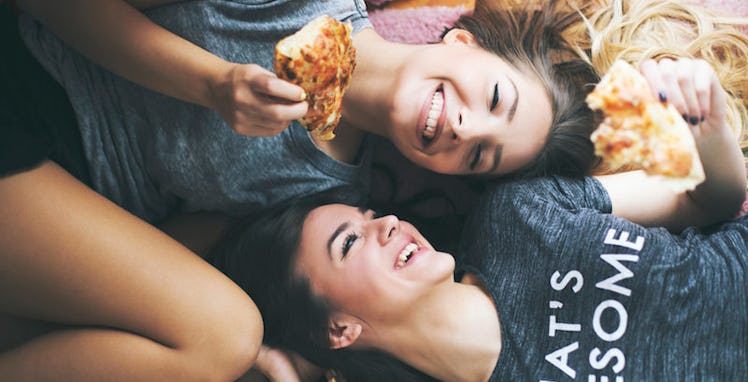
#NoFilter: The Connection Between Taking Selfies And A Healthier Body Image For Women
Ellen DeGeneres’s epic selfie proved what sexting teenagers and the Oxford Dictionary already knew: We are living in the Era of the Selfie.
Nearly every phone is manufactured with a camera that can now automatically face towards you and there’s even special equipment to ease the stress of having to cram all your friends in at only an arm’s length. We use them in advertisements, as fodder on Snapchat and in place of emojis to communicate our feelings to friends. The selfie has become integral to a family vacation album or excursion some place. Cher Horowitz’s signature technique of using Polaroids instead of mirrors just got a major upgrade now that we have smartphones.
There are two types of selfies: the Ellen DeGeneres kind that draws your attention away from the person in the camera and the more personal kind that directs your focus on the person up-close through the lens. Both invite you in, but the former makes an outside audience privy to an intimacy only the mirror could previously see.
Thanks to the Tumblrs and Instagrams of the world, viewing images of a wide array of women’s bodies via their uploaded selfies has become extremely easy and quite casual. We can scroll through a friend’s Facebook page that’s populated with full-body mirror photos at the gym or the head-to-toe looks from a budding fashionista. Regardless of what we are scanning, there’s always one common theme: a woman’s body.
For once, putting a woman’s body on display does not spell doom for the female gender. In fact, our selfies are actually a way of proliferating body acceptance. We’re now witnessing real girls from all different angles, perspectives, shapes and sizes. They’re on the beach, on the streets or just in their bathrooms. The more pedestrian the setting, the more accustomed we’ll become to seeing authentic women in a bona fide way.
What we may not realize is that selfies are powerful. As NYMag’s The Cut eloquently breaks down, “They’re poorly lit; they’re self-staged. Not only is there no airbrushing, but there’s no flattering lighting, no strategic body positions. They underscore the message of her accompanying words. They say, Here’s me. Just me.”
Look no further than the many female celebrities who are choosing to bare themselves -- no makeup, naked or otherwise -- for phones instead of photographers. Part of the reason we’re much more fascinated by their selfies than their glossies is that they’re raw; they strip away the Hollywood and put a celeb back in a more relatable, natural state. When these starlets showcase their imperfections, they’re simultaneously redefining what we consider to be flaws. Let’s face it: We can all can sleep better at night knowing Kate Moss has cellulite.
All personal annoyances aside, we’re able to see Kim Kardashian confidently flaunt her voluptuous curves without the E! cameras editing her in post-production. Kim doesn’t fit the size two mold and she’s not ashamed of it, but more importantly, neither is her audience. This is how she is choosing to present herself, and despite being a fake person, there’s something very genuine about that. We can at least embrace this act of sincerity in Kim and other celebrities.
Social media is a haven for us to unabashedly and shamelessly put ourselves out there -- usually for the validation from “likes” and feedback from friends and strangers. It would be fitting, then, that uploading selfies is an expression of this self-acceptance: You promote your real features in a positive light and random people voluntarily approve of both your self-confidence and appearance. We’re sending a message that says, “Yes, you are nice to look at.”
Take weight loss blogs and photo series, for example. We’re posting images of bodies that aren’t normally depicted in public, unless you’re watching a gruesome TLC special. These selfies, by contrast, are body-positive; that the female anatomy is beautiful at any weight and we should get used to seeing it that way. With all the Lena Dunhams and Robyn Lawleys of the world, it seems we just might be.
It is interesting to note, however, this meta phenomenon that is simultaneously happening: Are we, the users, now employing these bare selfies as yet another masked advertisement, for our own female nudity? Is this really us taking control of our bodies or are we putting them on display for others to judge?
Think about the sexy, often naked selfies both young and old girls (remember Alison Pill?) send to their lovers and friends. Are these promoting body acceptance or something else?
I ask this not to make us question whether these racy selfies are “good” or “bad,” but rather to point out that not all selfies are meant for public consumption, and thus, this selfie exists for a very different reason. Perhaps if we saw more of these naked selfies -- like how British magazines display a woman’s nipples -- pornography wouldn’t be such a taboo. But I digress…
There is also the question of filters. Do these undermine the body acceptance selfie movement? Using a preset option to enhance your tan, contour a leg or hide some blemishes definitely doesn’t sound certified organic, but then again, who can really tell the difference? If you’re bold enough to flash some selfie -- much like your size -- it shouldn’t matter how it’s packaged.
The bottom line is, it’s comforting and refreshing to see so many gorgeous, amazing women flaunting their bodies, their selfies, for the rest of us to praise on social media. It’s not wrong to be proud of yourself and your shape; it’s wrong not to accept it.